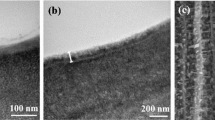Abstract
We conducted a novel non-visual screen for cuticular wax mutants in Arabidopsis thaliana (L.) Heynh. Using gas chromatography we screened over 1,200 ethyl methane sulfonate (EMS)-mutagenized lines for alterations in the major A. thaliana wild-type stem cuticular chemicals. Five lines showed distinct differences from the wild type and were further analyzed by gas chromatography and scanning electron microscopy. The five mutants were mapped to specific chromosome locations and tested for allelism with other wax mutant loci mapping to the same region. Toward this end, the mapping of the cuticular wax (cer) mutants cer10 to cer20 was conducted to allow more efficient allelism tests with newly identified lines. From these five lines, we have identified three mutants defining novel genes that have been designated CER22, CER23, and CER24. Detailed stem and leaf chemistry has allowed us to place these novel mutants in specific steps of the cuticular wax biosynthetic pathway and to make hypotheses about the function of their gene products.






Similar content being viewed by others
Abbreviations
- EMS:
-
Ethyl methane sulfonate
- SEM:
-
Scanning electron microscopy
- SSLP:
-
Simple sequence length polymorphism
- WT :
-
Wild type
References
Aarts MGM, Keijzer CJ, Stiekema WJ, Pereira A (1995) Molecular characterization of the CER1 gene of Arabidopsis involved in epicuticular wax biosynthesis and pollen fertility. Plant Cell 7:2115–2127
Avato P, Bianchi G, Salamini F (1984) Genetic control of epicuticular lipids in maize (Zea mays L.). In: Siegenthaler PA, Eichenberger W (eds) Structure, function and metabolism of plant lipids. Elsevier, Amsterdam, pp 503–506
Baker EA (1982) Chemistry and morphology of plant epicuticular waxes. In: Cutler DF, Alvin KL, Price CE (eds) The plant cuticle. Academic Press, London, pp 139–165
Bell CJ, Ecker JR (1994) Assignment of 30 microsatellite loci to the linkage map of Arabidopsis. Genomics 19:137–144
Chen X, Goodwin M, Boroff VL, Liu X, Jenks MA (2003) Cloning and characterization of WAX2 gene of Arabidopsis involved in cuticle membrane and wax production. Plant Cell 15:1170–1185
Dellaert LMW, Van Es JYP, Koornneef M (1979) Eceriferum mutants in Arabidopsis thaliana (L.) Heynh: II. Phenotypic and genetic analysis. Arabidopsis Inf Serv 16:10–26
Edwards K, Johnstone C, Thompson C (1991) A simple and rapid method for preparation of plant genomic DNA for PCR analysis. Nucleic Acids Res 19:1349
Hansen JN, Pyee J, Xia Y, Wen T, Roberston DS, Kolattukudy PE, Nikolau BJ, Schnable PS (1997) The GLOSSY1 locus of maize and an epidermal-specific cDNA from Kleinia odora define a class of receptor-like proteins required for the normal accumulation of cuticular waxes. Plant Physiol 113:1091–1100
Hülskamp M, Kopczak SD, Horejsi TF, Kihl BK, Pruitt RE (1995) Identification of genes required for pollen–stigma recognition in Arabidopsis thaliana. Plant J 8:703–714
Jenks MA (2002) Critical issues with the plant cuticle’s function in drought tolerance. In: Wood AJ (ed) Biochemical & molecular responses of plants to the environment. Research Signpost Press, Kerala, India, pp 97–127
Jenks MJ, Rich PJ, Peters PJ, Axtell JD, Ashworth EN (1992) Epicuticular wax morphology of bloomless (bm) mutants in Sorghum bicolor. Int J Plant Sci 153:311–319
Jenks MA, Tuttle HA, Eigenbrode SD, Feldmann KA (1995) Leaf epicuticular waxes of the eceriferum mutants in Arabidopsis. Plant Physiol. 108:369–377
Jenks MA, AM Rashotte, HA Tuttle, KA Feldmann (1996) Mutants in Arabidopsis thaliana altered in epicuticular wax and leaf morphology. Plant Physiol 110:377–385
Jenks MA, Eigenbrode S, Lemeiux B (2002) Cuticular waxes of Arabidopsis. In: Somerville C, Meyerowitz E (eds) The Arabidopsis book. American Society of Plant Biologists, Rockville, MD, pp 1–24
Kolattukudy PE (1996) Biosynthetic pathways of cutin and waxes and their sensitivity to environmental stresses In: Kersteins G (ed) Plant cuticles. BIOS, Oxford, pp 83–108
Koornneef M, Stam P (1992) Genetic analysis. In: Koncz C, Chua NH, Schell J (eds) Methods in Arabidopsis research. World Scientific, New Jersey, pp 83–99
Koornneef M, Hanhart CJ, Thiel F (1989) A genetic and phenotypic description of eceriferum (cer) mutants in Arabidopsis thaliana. J Hered 80:118–122
Lemieux B (1996) Molecular genetics of epicuticular wax biosynthesis. Trends Plant Sci 1:312–318
Lemieux B, Koornneef M, Feldmann KA (1994) Epicuticular wax and eceriferum mutants. In: Meyerowitz EM, CR Somerville CR (eds) Arabidopsis. Cold Spring Harbor Laboratory Press, Cold Spring Harbor, NY, pp 1031–1047
Macey MK, Barber HN (1970a) Chemical genetics of wax formation on leaves of Pisum sativum. Phytochemistry 9:5–12
Macey MK, Barber HN (1970b) Chemical genetics of wax formation on leaves of Brassica oleracea. Phytochemistry 9:13–23
McNevin JP, Woodward W, Hannoufa A, Feldmann KA, Lemieux B (1993) Isolation and characterization of eceriferum (cer) mutants induced by T-DNA insertions in Arabidopsis thaliana. Genome 36:610–618
Post-Beittenmiller D (1998) The cloned Eceriferum genes of Arabidopsis and the corresponding Glossy genes in maize. Plant Physiol Biochem 36:157–166
Rashotte AM, Feldmann KA (1998) Correlations between epicuticular wax structures and chemical composition in Arabidopsis thaliana. Int J Plant Sci 159:773–779
Rashotte AM, Jenks MA, Feldmann, KA (2001) Cuticular waxes on eceriferum mutants of Arabidopsis thaliana. Phytochemistry 57:115–123
Riederer M, Markstädter C (1996) Cuticular waxes: a critical assessment of current knowledge. In: Kerstiens G (ed) Plant cuticles: an integrated functional approach. BIOS, Oxford, pp 189–200
Vioque J, Kolattukudy PE (1997) Resolution and purification of an aldehyde-generating and alcohol-generating fatty acyl CoA reductase from pea leaves (Pisum sativum L.). Arch Biochem Biophys 340:64–72
von Wettstein-Knowles P (1995) Biosynthesis and genetics of waxes. In: Hamilton RJ (ed) Waxes: chemistry, molecular biology and functions. The Oily Press, Dundee, Scotland, pp 91–130
Acknowledgements
We acknowledge support from the NSF/DOE/USDA training grant (BIR-9220332) and NSF grant IBN-9419093. We thank the imaging facility of the Biotechnology Institute at The University of Arizona for electron microscopy support and the members of the Feldmann Laboratory for their comments and suggestions in the preparation of this manuscript.
Author information
Authors and Affiliations
Corresponding author
Rights and permissions
About this article
Cite this article
Rashotte, A.M., Jenks, M.A., Ross, A.S. et al. Novel eceriferum mutants in Arabidopsis thaliana . Planta 219, 5–13 (2004). https://doi.org/10.1007/s00425-003-1197-y
Received:
Accepted:
Published:
Issue Date:
DOI: https://doi.org/10.1007/s00425-003-1197-y




